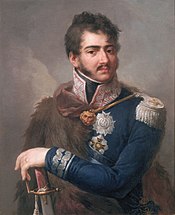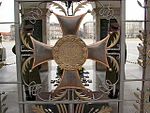Virtuti Militari
| Virtuti Militari War Order of Virtuti Militari Order Wojenny Virtuti Militari | |
|---|---|
Polonia Restituta |
The War Order of Virtuti Militari (
It is awarded in five classes either for personal heroism or, to commanders, for leadership.[4] Some of the heroic actions recognized by an award of the Virtuti Militari are equivalent to those meriting the British Victoria Cross[5] and the American Medal of Honor.[6]
Soon after its introduction, however, the Polish–Lithuanian Commonwealth was destroyed in the partitions of Poland (1795), and the partitioning powers abolished the decoration and prohibited its wearing. Since then, the award has been reintroduced, renamed and banned several times, with its fate closely reflecting the vicissitudes of the Polish people. Throughout the decoration's existence, thousands of soldiers and officers, Polish and foreign, several cities and one ship have been awarded the Virtuti Militari for valor or outstanding leadership in war. There have been no new awards since 1989.[7]
Beginnings
Medal chapter (1792–1794) • Lt.Gen. Józef Poniatowski, Tadeusz Kościuszko |

Throughout its history, the War Order of Virtuti Militari has shared its country's fate, and has been abolished and reintroduced several times.
The order was originally created on 22 June 1792 by

The first members of the decoration's chapter were also its first recipients. For the Polish-Russian War in Defence of the Constitution of 1792, a total of 63 officers and 290 NCOs and privates were awarded the Virtuti Militari. The statute was never fully implemented, however, since soon after its introduction the King acceded to the Targowica Confederation, which on 29 August 1792 abolished the decoration and prohibited its wearing.[2] Anyone who wore the medal could be demoted and expelled from the army by Poland's new authorities.
Although on 23 November 1793 the
Among the most famous recipients of the Virtuti Militari in this period were Prince
| Virtuti Militari Ribbon Bars | ||||
|---|---|---|---|---|
Duchy of Warsaw
Recipients (1806–1815) I Class (2 awarded): Louis Nicolas Davout (22 March 1809)II Class (10 awarded): • Józef Zajączek (1 February 1808) • Jan Henryk Dąbrowski (6 March 1808) • Karol Kniaziewicz (17 November 1812) • Stanisław Fiszer (22 August 1809) • Michał Sokolnicki (22 August 1809)• Aleksander Rożniecki (22 August 1809) • Józef Chłopicki (26 November 1810) • Amilkar Kosiński (17 November 1812) • Ludwik Pac (1 October 1813) • Mikołaj Bronikowski III Class (504 awarded) IV Class (23 awarded) V Class (1130 awarded) |

In 1806, Lt. Gen. Prince
- I Class – Grand Cross (with Star) (Krzyż Wielki z Gwiazdą, for commanders in chief)
- II Class – Commander's Cross (Krzyż Komandorski, for division commanders)
- III Class – Knight's Cross (Krzyż Kawalerski, for brigadiers, colonels and majors)
- IV Class – Golden Cross (Krzyż Złoty)
- V Class – Silver Cross (Krzyż Srebrny)

Initially each of the high commanders of the Army had a
Among the famous recipients of the medal in this period were General
Congress Poland

Recipients (1830–1831) I Class (none awarded) Jan Skrzynecki (for the battles of Wawer and Dębe Wielkie )III Class (105 awarded) IV Class (1794 awarded) e.g. Antoni Patek V Class (1963 awarded) |
In 1815 at the Congress of Vienna, when European powers reorganised Europe following the Napoleonic wars, the Kingdom of Poland—known unofficially as the "Congress Poland"—was created. This state, with a tenth the area of the Polish–Lithuanian Commonwealth and a fifth of its population, was now tied to Russia in a personal union. In Congress Poland, the Virtuti Militari medal was renamed the "Polish Military Medal" (Medal Wojskowy Polski).[2] Both the statutes of Virtuti Militari and privileges granted to recipients were preserved. A special commission was created to award the Virtuti Militari to veterans of the Napoleonic campaigns of 1812, 1813, and 1814. By 1820, an additional 1,213 crosses of all classes had been awarded.[8] Also, on 5 June 1817, a royal decree ennobled all officers who received the Golden Cross.
At the time, the Kingdom of Poland was one of the few
Provisional chapter (1920) • Gen. Józef Haller de Hallenburg • Lt.Gen. Wacław Iwaszkiewicz • Brig. Franciszek Latinik, Jan Romer, Edward Rydz • Col. Mieczysław Kuliński, Stanisław Skrzyński • Maj. Mieczysław Mackiewicz • Capt. Andrzej Kopa, Adam Koc |
After the outbreak of this uprising against
- head surgeon of the 10th Line Infantry Regiment, Józefa Kluczycka
- surgeon's assistant in the 10th Line Infantry Regiment, Józefa Daniel Rostowska née Mazurkiewicz
- cadet in the 1st "Augustów" Cavalry Regiment, Bronisława Czarnowska
After the defeat of the uprising, Tsar Nicholas I abolished the decoration and banned its use.[12] On 31 December 1831 it was replaced with the "Polish Sign of Honor" (Polski Znak Honorowy), an exact copy of the original cross but awarded only to Russians for services to the Tsarist authorities.[13]
Republic of Poland
Recipients (1920–1939) I Class (6 awarded): Vittorio Emmanuele III II Class (19 awarded): • Field Marshals: Yasukata Oku (Japan)• Kageaki Kawamura (Japan)• Armando Diaz (Italy) • Gen. Zygmunt Zieliński • Stanisław Szeptycki • Maxime Weygand (France) • Lucjan Żeligowski • John Pershing (United States)• Duke of Aosta Emmanuele Filiberto (Italy) • Gen.dyw. Edward Rydz • Stanisław Haller de Hallenburg • Jan Romer • Kazimierz Sosnkowski • Leonard Skierski • Władysław Sikorski • Wacław Iwaszkiewicz • Duke of Torino Emmanuele Filiberto (Italy) • Tadeusz Jordan-Rozwadowski III Class (14 awarded) • ppłk Gustaw Paszkiewicz, Maj. Zygmunt Piasecki • and 11 foreigners IV Class (50 awarded) • • Maj. Zygmunt Piasecki • rotm Stanisław Radziwiłł (posthumously)• Sgt. Kazimierz Sipika, Stanisław Jakubowicz • and 43 foreigners Class V (8,300 awarded) • Mieczyslaw Garsztka • Stanislaw Jackowski • Walery Sławek • Including: 1,800 posthumously and 187 to foreigners |


Poland regained its independence in 1918 as the
- Grand Cross with Star, Class I: "for a commander who has achieved victory in a battle of strategic importance, resulting in total defeat of the enemy, or a successful defense that has decided the fate of a campaign."
- Commander's Cross, Class II: "for a commander who has achieved a notable tactical victory or a valorous and successful defense of a difficult position."
- Knight's Cross – Class III: for officers, NCOs, and ordinary soldiers, previously awarded the Golden Cross, for acts of outstanding bravery, risk of life or outstanding command over his troops.
- Golden Cross – Class IV: for officers who commanded their troops with outstanding bravery and valor, and for NCOs and ordinary soldiers, previously awarded the Silver Cross, for acts of outstanding bravery and risk of life on the field of battle.
- Silver Cross – Class V: for officers, NCOs, and ordinary soldiers, for acts of outstanding bravery and risk of life on the field of battle.
Each recipient of the Virtuti Militari, regardless of rank or post, received a yearly salary of 300
Other privileges included the right of pre-emption when buying a state-owned land property or applying for a state post. Children of recipients received additional points during examinations in state schools and universities. Additionally, recipients of the Virtuti Militari had a right to be saluted by other soldiers of equal rank and NCOs, and ordinary soldiers could be promoted to the next higher rank upon receiving the award.
The new Chapter of the decoration (Kapituła Orderu Virtuti Militari) was comprised twelve recipients of the crosses, four from each class from I to IV. The head of the chapter was
On 1 January 1920
A new Chapter was chosen for times of peace on 24 November 1922. The following year, the last decoration of the Virtuti Militari was granted for World War I and the

Also, the criteria for granting the crosses became more strict:
- Grand Cross – Class I: for the commander-in-chief who won a war or, alternatively, for commanders of armies or fronts who achieved outstanding victories during various campaigns of the war.
- Commander's Cross – Class II: for the commander of an army or front (under special circumstances, also the commander of a group, division, or brigade) for brave and daring command during an operation which had important influence on the outcome of the war, or for other officers who contributed to the victory.
- Knight's Cross – Class III: for commanders of units up to the size of an army, for their outstanding leadership, initiative, or bravery; alternatively, for staff officers for their co-operation with their commanders that led to the final victory in a battle or war.
- Golden Cross – Class IV: for a soldier or officer, who was previously awarded the Silver Cross and achieved outstanding success on the battlefield thanks to his personal bravery or outstanding command of a division or a smaller unit.
- Silver Cross – Class V: for commanders who exercised daring and valorous command over their troops, or for ordinary soldiers who influenced their comrades in arms by their bravery, thus adding to the final victory in a battle.
The Silver Cross could also be awarded to military units, cities and civilians. All classes of the Virtuti Militari medal were awarded by the commander-in-chief during the war or former commander-in-chief after the end of hostilities. Classes I to III were awarded after nomination by the Chapter; Classes IV and V were nominated through the chain of command (usually by the commander of a division or brigade). Apart from the twelve members of the Chapter, all recipients of Class I had a right to take part in the voting.
World War II
Recipients (1939–1945) ( Exile )II Class (3 awarded): Michał Karaszewicz-Tokarzewski III Class (6 awarded) • Lt General Władysław Anders • Lt General Stanisław Maczek • Brigadier General Bronisław Duch • Lt General Tadeusz Kutrzeba • Brigadier General Franciszek Kleeberg • Brigadier General Antoni Chruściel IV Class (201 awarded) V Class (5363 awarded) • Brigadier General Wilhelm Orlik-Rueckemann • Commander Bolesław Trzaskowski • City of Warsaw for Heroic defence in 1939 |
During the
Following the fall of Poland in 1939, much of the Polish Army was evacuated to France, where it was reconstructed under the command of General
Among the most famous recipients of the medal during this period were
People's Republic of Poland
Recipients (1943–1990) PRL I Class (13 awarded): Konstanty Rokossowski • Marshal Michał Rola-Żymierski • General Aleksei Antonov • Marshal Leonid Brezhnev (revoked 1990) • Marshal of Yugoslavia Josip Broz Tito • Major General Nikolai Bulganin • Marshal Andriey Grechko • Marshal Ivan Koniev • Marshal Alexander Vasilievski • Marshal Georgy Zhukov • Field Marshal Bernard Montgomery • General Ludvík Svoboda • General Karol Świerczewski (posthumous) II Class (18 awarded): • Lt General Stanisław Popławski • Lt General Juliusz Rómmel • Lt General Karol Świerczewski • Major Henryk Sucharski III Class (57 awarded) • Lt General Bolesław Kieniewicz • Lt General Władysław Korczyc • Lt General Marian Spychalski IV Class (227 awarded) • Captain Władysław Raginis (posthumous) V Class (4852 awarded) |

The
Although the decree of the Polish Committee of National Liberation was loosely based on the act of the Polish
Among the recipients of the Golden Cross (Class IV) was destroyer ORP Błyskawica, probably the only warship in the world to be awarded the highest-ranking national medal.[21] Błyskawica Recipients of Class V of the Virtuti Militari included military units, including two infantry divisions, six infantry regiments, three artillery regiments, four tank regiments, three air force regiments, as well as smaller units.[22]
Republic of Poland (after 1989)

After Poland overthrew the Communist rule in 1989, a number of Virtuti Militari awards made by the communist authorities were brought into question. On 10 July 1990, President Wojciech Jaruzelski revoked the Grand Cross given to Leonid Brezhnev on 21 July 1974. On 16 October 1992, the Polish Sejm passed a new Virtuti Militari Act, which is based on the act of 1933. It restored the Chapter of Virtuti Militari abolished by the communist authorities, while also confirming all decorations bestowed by both the Polish government in exile and the Soviet-backed authorities in Poland.[23]
In 1995, President Lech Wałęsa revoked the Order given to Ivan Serov, who was accused of being responsible for the deaths of thousands of Poles.[24] In 2006, President Lech Kaczyński revoked the Cross of the Order given to Wincenty Romanowski, who tortured anti-Communist fighters.[25]
Since 1989 there have been no new awards of the Virtuti Militari, and a new act of parliament introduced a rule setting the final deadline for awards at "no later than five years after the cessation of hostilities."[26]
In wartime, the President of the Republic of Poland could award the OWVM for heroism in battle.[27]
See also
- Recipients of the Virtuti Militari
- Polish Scouting Cross
- Polish awards and decorations
- List of military decorations
References
- ^ The Order of Saint George is conferred by the Russian government; as the modern Virtuti Militari itself, the present-day Order of Saint George is a revival: in its case, of a military order first established in 1769. The Purple Heart, still awarded by the United States of America, stems from a military award established in 1782.
- ^ a b c d e f g h i j k "22 czerwca 1792 roku ustanowienie Orderu Wojennego Virtuti Militari". www.wspolnota-polska.org.pl (in Polish). Retrieved 2009-02-28.
- ^ Berkovits, Annette Libeskind. "What is the Oldest Military Decoration in the World Still in Use? | Annette Libeskind Berkovits". annetteberkovits.com. Retrieved 2021-03-17.
- ^ "Order Wojenny Virtuti Militari". www.prezydent.pl (in Polish). Archived from the original on 2006-09-15. Retrieved 2009-02-28.
- ^ "My Polish father-in-law did more for Britain than any graffiti-spraying racist". Retrieved 15 April 2020.
- ISBN 9780313260070. Retrieved 15 April 2020.
- ^ ""Niegodni" Virtuti Militari. W Kancelarii Prezydenta przegląd orderów nadanych w PRL". Retrieved 15 April 2020.
- ^ "Virtuti Militari. Njwyższe odznaczenie wojskowe". Retrieved 15 April 2020.
- ^ "W nocy z 29 na 30 listopada 1830 r. wybuchło Powstanie Listopadowe". Retrieved 15 April 2020.
- ^ "Wybuch Powstania Listopadowego". Retrieved 15 April 2020.
- ^ "Kulczycka Józefa" (PDF). Retrieved 15 April 2020.
- ^ "225. rocznica ustanowienia Orderu Virtuti Militari". Retrieved 15 April 2020.
- ^ "Polski Znak Honorowy 1831 – wzorowana na Virtuti Militari odznaka rosyjska za stłumienie Powstania Listopadowego". Retrieved 15 April 2020.
- ^ "II Rzeczpospolita przywróciła Order Orła Białego i Krzyż Virtuti Militari, przy tym jednak ustanowiła kilka zupełnie nowych odznaczeń". Retrieved 15 April 2020.
- ^ "Virtuti Militari. Njwyższe odznaczenie wojskowe". Retrieved 15 April 2020.
- ^ "Virtuti Militari – z cyklu "Droga do niepodległości"". Retrieved 15 April 2020.
- ^ "Odznaczenie Lwowa Orderem Virtuti Militari". Retrieved 15 April 2020.
- ^ ""Semper Fidelis", czyli za co Lwów odznaczono Orderem Virtuti Militari". Retrieved 15 April 2020.
- ^ "OKRES 1918–1939". Retrieved 15 April 2020.
- ^ "Order Virtuti Militari przyznawano również wrogom Polski". Retrieved 15 April 2020.
- ^ "80 lat ORP". Retrieved 15 April 2020.
- ^ "80 lat ORP". Retrieved 15 April 2020.
- ^ "Order Virtuti Militari przyznawano również wrogom Polski". Retrieved 15 April 2020.
- ^ ""Niegodni" Virtuti Militari. W Kancelarii Prezydenta przegląd orderów nadanych w PRL". Retrieved 15 April 2020.
- ^ ""Niegodni" Virtuti Militari. W Kancelarii Prezydenta przegląd orderów nadanych w PRL". Retrieved 15 April 2020.
- ^ "Ustanowienie Orderu Virtuti Militari". Retrieved 15 April 2020.
- ^ "225. rocznica ustanowienia Orderu Virtuti Militari". Retrieved 15 April 2020.
- Zdzisław P. Wesołowski (1992). The Order of Virtuti Militari and its cavaliers: 1792–1992. Miami, FL: Hallmark Press. OCLC 31364118.
- Tadeusz Jeziorowski (1993). Order wojenny Virtuti Militari. Poznań, Muzeum Narodowe. ISBN 978-83-85296-17-1.
- Bogusław Polak (1999). Virtuti Militari 1919–1997: wybór źródeł. Koszalin, Wydawnictwo Uczelniane Politechniki Koszalińskiej. ISBN 978-83-87424-87-9.
- Elżbieta Zawacka; Dorota Kromp; Maria Biernacka (2004). Słownik biograficzny kobiet odznaczonych Orderem Wojennym Virtuti Militari. Toruń, Archiwum i Muzeum Pomorskie Armii Krajowej oraz Wojskowej Służby Polek. ISBN 978-83-88693-03-8.






